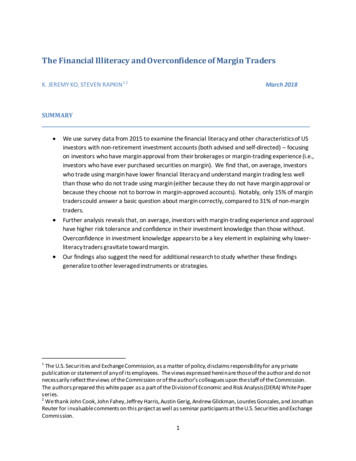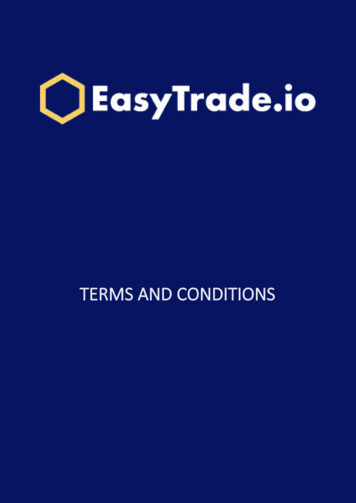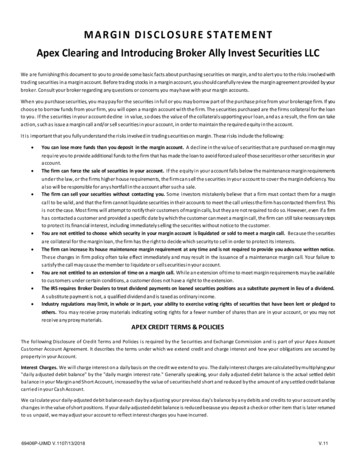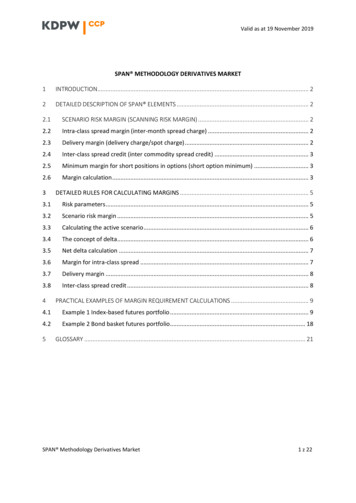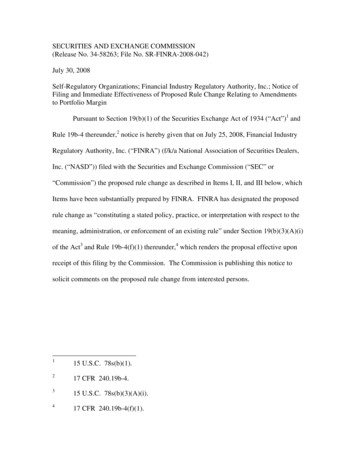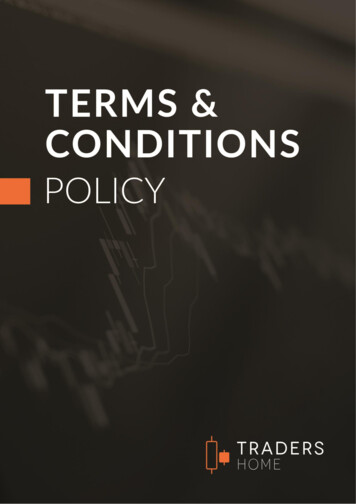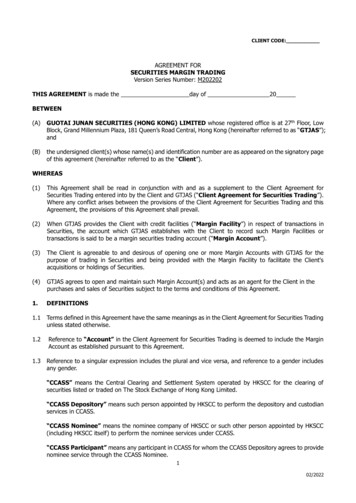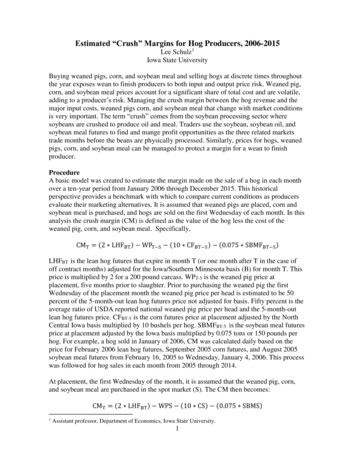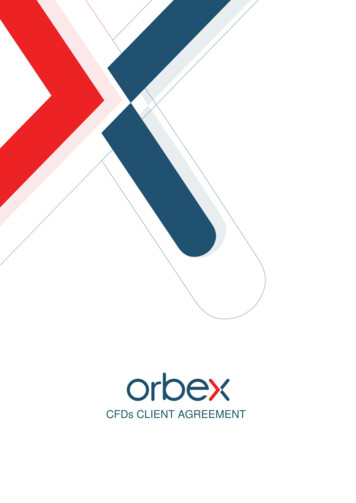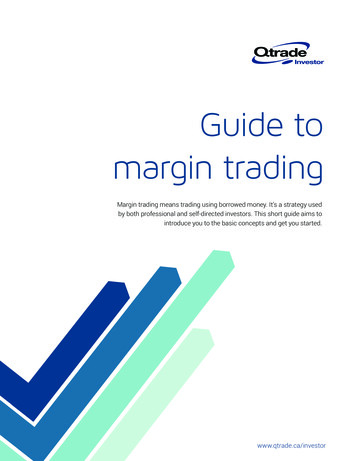
Transcription
Guide tomargin tradingMargin trading means trading using borrowed money. It’s a strategy usedby both professional and self-directed investors. This short guide aims tointroduce you to the basic concepts and get you started.www.qtrade.ca/investor
Qtrade Investor Guide to margin tradingGuide to margin tradingMargin trading is the practice of borrowing money from a brokerage to trade in stocks orother types of securities. Stocks held in your account are used as collateral for the loan, andthe brokerage charges interest for the duration of the loan. In the investment world, buyingstocks using borrowed money is known as trading ‘on margin.’When the price of a stock is rising, trading on margin allows investors to use leverage toincrease their gains. However, when stock prices fall, losses mount much more quickly.This guide provides:12345678A definition of margin tradingMargin trading examples and scenariosExplanation of margin accountsA “quick start” guide to margin tradingA guide to opening a margin accountMargin trading best practices and guidelinesSample Qtrade Investor margin requirementsA glossary of margin trading termsFor further help with margin accounts or margin trading with Qtrade Investor, please speak to one of ourinvestment representatives. Call 1.877.787.2330 or 604.605.4199, or send an email to info@qtrade.ca.2
Qtrade Investor Guide to margin tradingWhat is margin trading?Margin trading is the practice of borrowing money from a brokerage to trade in stocks orother types of securities. Stocks held in your account are used as collateral for the loan, andthe brokerage charges interest for the duration of the loan. In the investment world, buyingstocks using borrowed money is known as trading ‘on margin.’When the price of a stock is rising, trading on margin allows investors to use leverage toincrease their gains. However, when stock prices fall, losses mount much more quickly.Example:Sam holds 1,000 shares in XYZ Inc. and would like to buy 500 more. Rather than useher own cash to buy the additional shares, she opts to borrow from her broker, usingher original 1,000 shares as collateral for the loan.Within her margin account Sam buys 500 shares in XYZ Inc. at 50 per share.Scenario 1: price rises to 60 per shareScenario 2: price falls to 40 per shareSam sells the 500 shares one monthlater at 60 per share*.Sam sells the 500 shares one monthlater at 40 per share*.She pays her broker back the 25,000she borrowed plus one month’sinterest**, which amounts to 125, or 25cents per share.She pays her broker back the 25,000she borrowed plus one months’interest** which equates to 125, or 25cents per share.This leaves profits of 9.75 per share.This leaves a loss of 10.25 per share tobe paid from her existing XYZ Inc. stock.Sam’s account is now worth 64,975( 60,000 stock in XYZ Inc. plus 4,975profit from her margin trade).Sam’s account is now worth 34,875( 40,000 stock in XYZ Inc. minus a 5,125 loss from her margin trade).* These scenarios do not account for the cost of trading commissions.** For this illustration, interest is calculated at 6% annually. To find out current interest rates for QtradeInvestor margin accounts, call 1.877.787.2330 or 604.605.4199, or send an email to info@qtrade.ca.3
Qtrade Investor Guide to margin tradingQuick start to margin trading123456Understand the risks of trading on margin (start by reading this guide).Open a margin account.Add/buy stock to be used as collateral.Confirm your “buying power” — the amount you can borrow. This depends on theamount and type of stock you hold (see the table on page 9) and is usually in therange of 70% to 50% of the market value of your stock collateral.Place an order.Closely monitor your position.Margin accountsDefinitionsIn order to trade on margin, you need to open a margin account.You can’t trade on margin within a cash account or within aregistered account such as a TFSA, RSP, RIF, or RESP.When you open a margin account, you will start by depositinga minimum amount of cash or margin-eligible securities. Yourbroker will lend you a portion of the market value of those assets,which act as collateral to secure the loan. The brokerage chargesinterest on the borrowed funds as long as the loan is outstanding.People most commonly borrow on margin in order to purchasestocks, although other securities can also be purchased, includingETFs, mutual funds, bonds, and options. You can also use amargin account to short sell stocks.4Margin excess: the amountof funds available in youraccount that are abovethe margin requirement.Those funds are available topurchase new securities orto add to an existing position.See page 10 for more margintrading definitions.
Qtrade Investor Guide to margin tradingMargin scenariosHere are further possible scenarios with several potential outcomes.Let’s say you’ve been following XYZ Inc. and you believe its marketvalue is likely to increase. The company’s stock currently tradesat 50 per share. You’d like to buy 100 shares, but you only have 3,000 available to invest. You could just buy 60 shares. But youdecide to borrow 2,000 from your broker on margin, and youpurchase 100 shares for a total of 5,000.Falling stock priceMargin trading can work against you if the stock price goes down.Imagine that shares of XYZ Inc. fall to 45. The market value ofyour position will be 4,500. You’ve invested your 3,000 principal,and borrowed 2,000, so if you pay off your margin loan, yourequity falls to only 2,500. You’re down 500 and you’re stillaccruing interest on your 2,000 loan.You don’t necessarily need to do anything, not yet anyway. Butnotice that your margin ratio has changed. You’ve borrowed 2,000 to buy an asset that is now worth 4,500. So your marginhas fallen to about 55%. You’ll need to keep a close eye on thissituation and understand your broker’s margin requirements. Ifthe stock price continues to fall, you may get what’s known as a“margin call.” (See the sidebar: “Meeting the call”).Rising stock priceLet’s say that your analysis of XYZ’s prospects turns out to becorrect. The stock goes up to 60 per share. Your position is worth 6,000, while your margin loan is 2,000. If you sell that position,and pay off your margin loan, you’ll have 4,000. You started with 3,000, so you’re up 1,000, or 33%. Pretty good.If you had only purchased 60 shares, and sold them at 60, youwould have 3,600, which is a 20% gain. Still good, but not asgood as the outcome you generated by trading on margin. Withyour margin loan, you used leverage to increase your return.(Keep in mind that those outcomes do not include loan interestand trading commissions, which will lower your returns.)5Meeting the callYou would receive a“margin call” if you hadpurchased stocks onmargin, and the value ofyour account decreased tothe point where your marginwas below the minimummargin required by yourbroker. Your broker will askyou to take prompt action inorder to restore the requiredmargin. In order to “meetthe call,” you’ll need to putmore cash and/or moremargin-eligible securitiesinto your brokerageaccount. If you can’t comeup with more securities, orcash, then you would needto sell some of your stockand apply the proceedsto your margin loan – atleast enough to restore thebalance. If you do not actpromptly, your broker willsell enough of your stockto put the account intopositive margin.
Qtrade Investor Guide to margin tradingExample: boosting your returns using marginCash onlyUsing marginSecurities purchased at 50share priceBuy 60 shares for 3,000Buy 100 shares for 5,000Margin credit 0 2,000Proceeds from selling at 60share price 3,600 6,000Amount remaining after loanpaybackn/a 4,000Gain* 600 1,000Return on investment20%33%*(Calculation does not include loan interest and trading commissions.)If the stock price is unchangedMargin loans, when used well, can work in your favour. However,you are taking on a debt which must eventually be paid off. In themeanwhile, as with any loan, you’ll pay interest on the outstandingdebt, regardless of whether the stock price of XYZ Inc. goes up,down, or sideways.Worst caseIf the price of your stock plummets drastically, you can end upwith a margin loan that exceeds the market value of the stock.Even selling all the stock wouldn’t raise enough to repay the loan.Regardless of how much the value of your securities declines, youare still responsible for repaying the loan. Leverage is a doubleedged sword: it can increase gains on the upside, but it can alsoamplify your losses on the downside.6Traders’ tipMargin and leverage areconcepts that go handin-hand. Leverage is adouble-edged sword: itcan increase gains onthe upside, but it can alsoamplify your losses on thedownside.
Qtrade Investor Guide to margin tradingMargin requirementsA minimum margin must be maintained. Margin requirements are set by investment industryregulations, and by your brokerage’s risk management policies.Let’s say that the margin requirement for XYZ stock is 50%. And imagine that since youoriginally purchased your 100 shares at 50, the stock price has fallen to 39. At that point,your loan will be 51%, and your margin will be 49% of the market value of the stock. Sinceyour account has less than the minimum margin, you may get a margin call from yourbroker, asking you to take prompt action in order to restore the required account margin.In order to meet the call, you’ll need to deposit more cash and/or more margin-eligiblesecurities into your brokerage account. If you can’t come up with more securities, or cash,then you would need to sell some of your XYZ stock and apply the proceeds to your marginloan – at least enough to restore the balance. Unfortunately, that would mean realizinga capital loss on the sale of those stocks. If you receive a margin call, and you do not actpromptly, your broker will sell enough to put the account into positive margin.Margin trading best practicesIf you decide to buy on margin, take a careful, disciplined approach. Margin trading entailsadditional risks associated with market volatility, and requires a high level of attention,perhaps even monitoring stock prices on a daily basis. Keep these best practices in mind:Maintain a margin buffer in your accountDon’t be fully leveraged — try to keep your margin well above the broker’s requirement. For example,if the required margin is 50%, try to keep enough cash or margin-eligible securities in your accountto maintain the margin at 60% or more. That minimizes the chance of a margin call.Maintain a diversified portfolioMaintaining a diversified portfolio in your margin account reduces the risk that a singlesecurity’s drop in value will trigger a margin call.Monitor your positionsIf the markets become uncertain or negative, vigilantly monitor your margin positions.Consider using stop-market or stop-limit ordersStop-market and stop-limit orders can be used to restrict potential losses.7
Qtrade Investor Guide to margin tradingA stop-market order will automatically trigger the sale of your shares once the share pricefalls to a pre-set level — the stop price. The order is filled at the market price.In the case of a stop-limit order, you set two prices: the stop price and the limit price. Oncethe share price falls to the stop price, the order is converted to a limit order. Your shares willbe sold only at your specified limit price or better.Take time to educate yourself before using any stop-market and stop-limit orders, so thatyou understand the potential consequences. For example, stop-market orders will notnecessarily limit your losses to the stop price: in a volatile market, your actual sale pricecould be well below your stop price. In a stop-limit order, it may not be possible for the brokerto execute the order before the price falls below your limit price. Also keep in mind that involatile markets, stock prices can fall quickly but then recover quickly. In that case, using astop order could cause you to sell at a loss and miss out on the recovery.Factor in your interest paymentsAs with any loan, you pay interest when you purchase securities on margin. Rates arecompetitive, but the interest still reduces your profits. If you’re starting out with margintrading, consider buying stocks of large, stable companies that have a track record of payinga good dividend. If the dividend yield meets or exceeds the interest rate on your margin loan,then the stock pays its own way.Traders’ tipIf you decide to buy on margin, take a careful, disciplined approach.Margin trading entails additional risks associated with market volatility,and requires a high level of attention.Guidelines to be aware of A margin account that has a very large margined holding in one security or onesector, and little or no diversification in other holdings or sectors, can be deemed tobe “concentrated.” As a result, the loan value of the security may be reduced.8
Qtrade Investor Guide to margin tradingGet started with margin training:Step-by-step guide1234Complete our online application from your desktop or mobile device.Read our Customer Service and Disclosure Document, which provides the terms andconditions governing your margin account, and acknowledge that you’ve read andunderstood it.Fund your account using an Electronic Funds Transfer or bill payment from yourbanking account; or by transferring assets from another investment account.Start investing!For questions about margin accounts or margin trading, or about margin requirements and interest rates,speak to one of our knowledgeable investment representatives. Call 1.877.787.2330 or 604.605.4199, or sendan email to info@qtrade.ca.Sample Qtrade Investor margin loan valueExchange-listed equity priceMarginLoan amount 3.00 and on IIROC-approved list 5.00 30%70% 3.00– 4.9950%50% 2.99 or less100%Ineligible9
Qtrade Investor Guide to margin tradingMargin trading definitionsBuying on margin: borrowing money fromyour broker in order to purchase securities.Buying power: in a margin account, themaximum dollar amount of securities thatyou can purchase without having to depositadditional funds; you must have sufficientbuying power in your account at the timeyour margin order is placed (also see Marginexcess).Collateral: assets pledged to guarantee a loan,and which may be collected in case of default.Limit order: an order that sets the maximumor minimum at which you are willing to buy orsell a particular stock.Margin account: a brokerage account thatallows you to borrow funds from your broker.The cash and securities in your account actas collateral for the loan. The broker chargesinterest on the borrowed money.Margin call: a requirement to act when youraccount has exceeded the amount it canborrow. This can occur if the market value ofthe securities in your account falls, so thatyour margin falls below the requirement. Inthat case, you will need to either deposit morecash or marginable securities in your account,or sell some of the stock.Margin deposit: the amount of funds that youcontribute toward the purchase of securitiesin a margin account.Margin excess: the amount of funds availablein your account that are above the marginrequirement. Those funds are available topurchase new securities or to add to anexisting position (also see Buying power).Margin loan: the amount that you borrowfrom your broker in order to buy securities.You pay interest on the loan as long asit is outstanding. Normally, there is norequirement to repay the loan until the stockis sold. While the value of your security maygo up or down, the amount you owe thebrokerage should remain the same.Margin requirement: because the value ofthe marginable securities and cash in youraccount serves as collateral for your loan, youare required to maintain a certain minimumratio between the amount borrowed and thecurrent market value of the securities in themargin account. Margin requirements are setby securities industry regulators and by therisk management policies of the individualbrokerage.Marginable securities: securities that arepermitted to be used as collateral for amargin account.Non-marginable securities: securities thatare not permitted to be used as collateral fora margin account.Short selling: selling securities that you donot own. You “borrow”, with the intent to buyit back later at a lower price.Stop-limit order: an order where you set astop price and a limit price. Once the stopprice is hit, the order converts to a limit order,to be filled only at the limit price or better.Stop-market order: an order that becomesexecutable once a pre-determined price (stopprice) is hit; at that point the order is filled atthe market price.10
We’re here to help1.877.787.2330 or 604.605.4199info@qtrade.caQtrade Investor700 - 1111 West Georgia StreetVancouver, BC V6E 4T6Open an account at www.qtrade.ca/applyQtrade Investor is a division of Credential Qtrade Securities Inc., Member of the Canadian Investor Protection Fund. This material is forinformational purposes only. While this material has been compiled from sources believed to be reliable, Qtrade Investor does not guaranteethe accuracy, completeness, timeliness or reliability of this information. Information, figures and charts are summarized for illustrative purposesonly and are subject to change without notice. All investments are subject to risk, including the possible loss of principal.
Qtrade Investor Guide to margin trading 2 Guide to margin trading Margin trading is the practice of borrowing money from a brokerage to trade in stocks or other types of securities. Stocks held in your account are used as collateral for the loan, and the brokerage charges interest for the duration of the loan. In the investment world, buying
